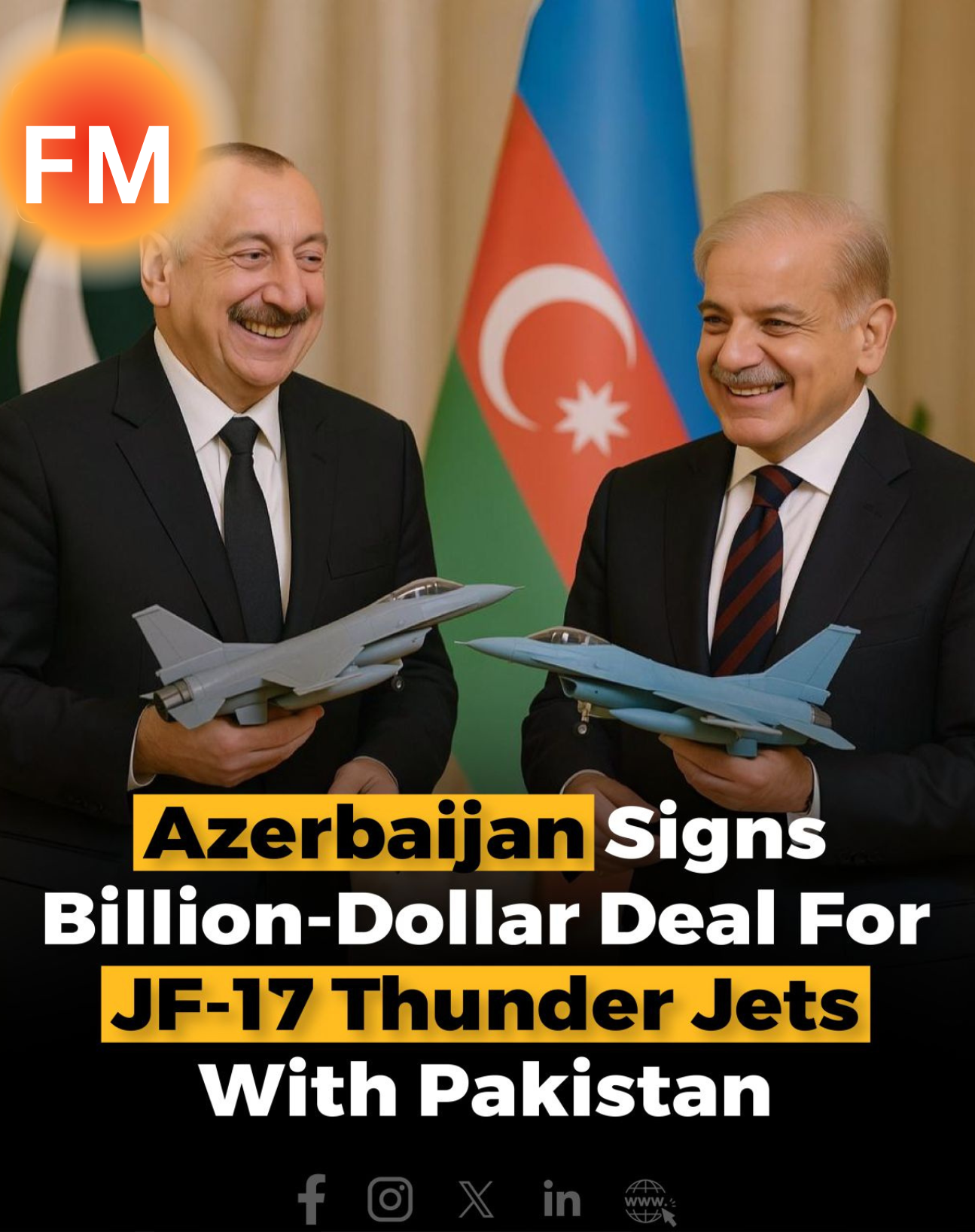Introduction
Azerbaijan has recently signed a landmark defense agreement with Pakistan to acquire the JF-17 Thunder Block III fighter jets in a deal worth an initial $1.6 billion, with potential expansion to $4.2 billion. This agreement marks a significant shift in Azerbaijan’s military strategy, enhancing its air combat capabilities amid rising tensions in the South Caucasus region. The deal includes not only the multirole fighter jets but also weapons systems, logistical support, and pilot training.
The JF-17 Thunder, co-developed by Pakistan Aeronautical Complex (PAC) and China’s Chengdu Aircraft Corporation (CAC), represents a cost-effective yet advanced solution for modern air forces. For Azerbaijan, this acquisition is a strategic move to counterbalance regional rivals, particularly Armenia, while reducing dependence on traditional suppliers like Russia and Turkey.
This article explores the details of the deal, the capabilities of the JF-17 Block III, the geopolitical implications for the Caucasus, and the broader impact on Pakistan’s defense exports.
The Azerbaijan-Pakistan Defense Agreement: Key Details
1. The $1.6 Billion Initial Deal
The agreement between Azerbaijan and Pakistan includes:
- JF-17 Thunder Block III fighter jets (estimated 16–24 units in the first phase)
- Advanced weaponry, including PL-15E beyond-visual-range (BVR) missiles and precision-guided munitions
- Maintenance and logistics support
- Pilot and ground crew training programs
The deal is structured in phases, with the first batch expected to be delivered by 2025–2026. Reports suggest that Azerbaijan may eventually procure up to 50 aircraft, pushing the total contract value to $4.2 billion, making it one of Pakistan’s largest defense exports.
2. Why Azerbaijan Chose the JF-17 Block III
Azerbaijan’s air force currently relies on Soviet-era MiG-29s and Su-25s, alongside Turkish and Israeli drones. The JF-17 Block III offers several advantages:
- Advanced Avionics: Features an AESA radar, superior to older Russian radars.
- Cost-Effectiveness: At around $50 million per unit, it is cheaper than Western alternatives like the F-16 or French Rafale.
- Compatibility with Chinese & Pakistani Munitions: Can deploy PL-15E BVR missiles (with a 145 km range) and smart bombs.
- Modern Electronic Warfare Systems: Enhanced survivability against enemy air defenses.
This acquisition aligns with Azerbaijan’s goal of modernizing its military after its victory in the 2020 Nagorno-Karabakh war, where drones played a decisive role but left a gap in manned fighter capabilities.
JF-17 Thunder Block III: A Game-Changer for Azerbaijan
1. Superior Technology Over Previous Blocks
The Block III variant is the most advanced version of the JF-17, featuring:
- KLJ-7A AESA Radar: Provides better detection range and multi-target tracking.
- Improved EW Suite: Enhanced electronic countermeasures to evade enemy missiles.
- HMDS (Helmet-Mounted Display System): Allows pilots to lock onto targets by looking at them.
- Refueling Probe (Optional): Extends mission range.
2. Comparison with Regional Competitors
Azerbaijan’s primary regional rival, Armenia, operates Su-30SM fighters, which are more powerful but fewer in number. The JF-17 Block III can effectively engage Armenian aircraft using PL-15E missiles, outranging Armenia’s current BVR capabilities.
Compared to Turkey’s F-16s, the JF-17 is less advanced but offers a more affordable solution with Chinese-Pakistani support, reducing reliance on Western supply chains.
3. Role in Azerbaijan’s Air Defense Strategy
Azerbaijan’s military doctrine emphasizes deterrence and rapid strike capabilities. The JF-17 will likely be used for:
- Air superiority missions against potential Armenian threats.
- Ground attack roles with precision-guided bombs.
- Reconnaissance and electronic warfare support.
Given Azerbaijan’s heavy use of Turkish Bayraktar TB2 drones, the JF-17s will complement unmanned systems by providing manned fighter cover.
Geopolitical Implications of the Deal
1. Strengthening Azerbaijan-Pakistan Relations
This deal deepens military ties between Azerbaijan and Pakistan, which have historically supported each other on issues like Karabakh and Kashmir. Pakistan was one of the few countries to openly back Azerbaijan in the 2020 Nagorno-Karabakh war, while Azerbaijan supports Pakistan’s stance on Kashmir.
2. Reducing Dependence on Russia
Traditionally, Azerbaijan has relied on Russian-made equipment (MiGs, Sukhois) and Israeli drones. However, after Russia’s neutral stance in the 2020 war, Baku has sought to diversify its arms suppliers. The JF-17 deal signals a shift towards China and Pakistan as key defense partners.
3. Impact on Armenia and Regional Balance
Armenia, which has a defense pact with Russia, may feel pressured to seek advanced fighters or air defense systems. If Russia fails to supply modern jets (due to its own war in Ukraine), Armenia might turn to France or India for alternatives, such as the Rafale or Tejas.
4. China’s Growing Influence in the Caucasus
Though the JF-17 is a Pakistani-Chinese project, China benefits from expanded defense exports. Azerbaijan is part of China’s Belt and Road Initiative (BRI), and this deal could pave the way for deeper military-industrial cooperation.
Pakistan’s Defense Export Ambitions
1. A Major Win for Pakistan’s Aerospace Industry
The JF-17 has been exported to Nigeria and Myanmar, but the Azerbaijan deal is the largest yet, boosting Pakistan’s credibility as a defense exporter. If the contract expands to $4.2 billion, it will significantly enhance Pakistan’s defense revenue.
2. Potential Future Customers
Countries like Iraq, Sudan, and Argentina have shown interest in the JF-17. A successful Azerbaijan deployment could attract more buyers, especially nations seeking affordable 4.5-generation fighters.
3. Challenges Ahead
While the JF-17 is cost-effective, it faces competition from:
- Turkish Hurjet & KAAN (in development)
- Indian Tejas (for African & Asian markets)
- Russian MiG-35 (if sanctions ease)
Pakistan must ensure timely deliveries and strong after-sales support to maintain its market position.
Conclusion: A Strategic Shift in the Making
The Azerbaijan-Pakistan JF-17 deal is more than just an arms transaction—it signifies Azerbaijan’s pivot towards Asian defense suppliers, Pakistan’s rise as a defense exporter, and a rebalancing of power in the Caucasus.
For Azerbaijan, the JF-17 Block III provides a technologically advanced, cost-efficient fighter to counter Armenian and regional threats. For Pakistan, this deal cements its role in the global arms market, opening doors for future exports.
As the first JF-17s arrive in Azerbaijan by 2025–2026, the geopolitical landscape of the South Caucasus will undoubtedly evolve, with China and Pakistan playing an increasingly influential role in the region’s defense dynamics.
Final Thoughts
- Azerbaijan gains a modern air force at a reasonable cost.
- Pakistan secures its biggest defense export deal yet.
- Armenia may seek countermeasures, possibly from France or India.
- Russia’s influence in the region could further decline.
- China expands its defense footprint in Eurasia.
This deal is a game-changer, not just for Azerbaijan and Pakistan, but for the entire Caucasus security architecture. The coming years will reveal how effectively the JF-17 Thunder Block III integrates into Azerbaijan’s military strategy and whether more nations follow suit in acquiring this formidable fighter jet.

